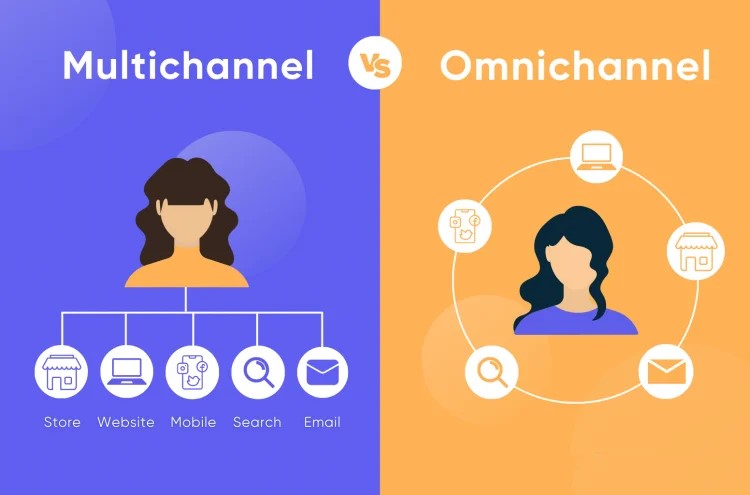
Conversely, multichannel marketing engages customers through various platforms without necessarily linking those channels. While it allows for broader outreach, it can lead to inconsistent customer experiences. As a result, you may miss opportunities to strengthen relationships with your audience.
Knowing which approach to use depends on your business goals and customer preferences. You should consider how your audience interacts with your brand across different touchpoints. By analyzing these interactions, you can tailor your marketing strategy to fit their needs. Ultimately, recognizing the strengths and weaknesses of each approach will help you make informed decisions. Adapting your strategy can improve customer satisfaction and drive sales.
Definition and Key Differences
Omnichannel and multichannel marketing are two distinct approaches to engaging customers. Both methods use various channels to reach audiences, but their execution differs significantly. Multichannel marketing involves utilizing multiple platforms, such as social media, email, and websites. However, these channels often operate independently. As a result, customers may experience inconsistent messaging and service.
In contrast, omnichannel marketing integrates all channels into a cohesive strategy. This approach aims to provide a seamless customer experience, regardless of the platform. For instance, if you shop online, you should receive the same personalized offers as when you visit a physical store. Omnichannel vs. multichannel marketing highlights this critical difference. With omnichannel strategies, your brand speaks with one voice, enhancing customer engagement.
Moreover, data usage differs between these two approaches. Multichannel marketing may track customer interactions on individual channels but often lacks a unified view. Omnichannel marketing, on the other hand, leverages customer data from all touchpoints. This data allows you to understand customer behavior more comprehensively. Consequently, you can create tailored experiences that encourage loyalty.
In summary, while both strategies aim to engage customers across multiple platforms, they differ in execution and effectiveness. Understanding these differences can help you choose the right approach for your marketing goals.
Customer Experience
Customer experience plays a significant role in the effectiveness of marketing strategies. Omnichannel vs. multichannel marketing shows how each approach impacts engagement across different platforms. In a multichannel approach, you may find that customer interactions occur across various channels but lack consistency. This can lead to confusion, as customers receive different messages depending on the platform they use. As a result, they may feel disconnected from your brand.
Conversely, omnichannel marketing creates a seamless experience for customers. This strategy integrates all touchpoints, allowing for a unified customer journey. For instance, if a customer interacts with your brand on social media and later visits your website, they should feel a consistent connection. This consistency fosters trust and encourages loyalty. You can engage customers more effectively by recognizing their preferences and behaviors across channels.
Additionally, omnichannel marketing allows for personalized interactions. By leveraging data from various sources, you can tailor your messaging to individual preferences. This personalized approach enhances customer satisfaction and drives engagement. In contrast, the multichannel method often lacks this level of personalization, which can result in missed opportunities.
In summary, the choice between omnichannel and multichannel marketing significantly impacts customer experience. Understanding these differences allows you to create a more engaging and cohesive experience for your audience. By prioritizing seamless interactions, you can build stronger relationships with your customers.
Integration and Consistency
Integration is a key aspect of successful marketing strategies. When comparing omnichannel vs. multichannel marketing, integration stands out as a major differentiator. In an omnichannel approach, all channels work together seamlessly. This creates a cohesive brand experience for your customers. They can move effortlessly between platforms, such as social media, email, and your website. This seamless interaction fosters a stronger connection with your brand.
In contrast, multichannel marketing often leads to a fragmented experience. Each channel may operate independently, resulting in inconsistent messaging and customer experiences. For instance, customers may encounter different promotions or tones across platforms. This lack of integration can confuse customers and reduce overall satisfaction. When customers feel disconnected, their loyalty may wane.
Moreover, integrated marketing allows for better data utilization. You can collect and analyze data from multiple channels to gain deeper insights into customer behavior. This information helps you tailor your marketing efforts and enhance customer engagement. In a fragmented multichannel approach, you may miss valuable insights that could inform your strategy.
Ultimately, integration in omnichannel marketing promotes consistency and builds trust. Customers appreciate a unified experience that recognizes their preferences across channels. By adopting an omnichannel approach, you create a more engaging and satisfying customer experience. This strategy not only strengthens relationships but also drives higher conversions and long-term loyalty.
Data Utilization
Data utilization plays a significant role in both omnichannel and multichannel marketing strategies. However, how you leverage customer data differs between the two approaches. In omnichannel marketing, you create a unified view of customer interactions across all channels. This approach allows you to collect data from various touchpoints, including websites, social media, and in-store visits. By analyzing this comprehensive data, you can gain deeper insights into customer behavior and preferences.
On the other hand, multichannel marketing often results in isolated data sets. Each channel may collect its own data without a clear connection to other platforms. This fragmentation can limit your ability to personalize marketing efforts effectively. For example, a customer may receive targeted offers via email but see unrelated promotions on social media. This inconsistency can reduce engagement and dilute the overall impact of your marketing efforts.
With omnichannel marketing, you can tailor messages based on a customer’s entire interaction history. For instance, if a customer browsed products online, you can send personalized recommendations through email or in-app notifications. This targeted approach increases the likelihood of conversions. Additionally, by continually analyzing customer data, you can refine your strategies and enhance customer satisfaction over time.
In summary, understanding the differences in data utilization between omnichannel vs. multichannel marketing is essential. By integrating data across channels, you can enhance targeting and create personalized experiences. Ultimately, this leads to better engagement and stronger customer relationships.
Benefits and Challenges
Implementing effective marketing strategies brings both benefits and challenges, especially when comparing omnichannel vs. multichannel marketing. Starting with the advantages, omnichannel marketing offers a seamless customer experience. You can provide consistent messaging across all platforms, enhancing customer satisfaction. Additionally, integrating data from various channels allows you to gain valuable insights into customer behavior. This insight can drive targeted campaigns that resonate better with your audience.
On the other hand, multichannel marketing allows you to reach customers on multiple platforms simultaneously. This approach can increase your brand visibility and attract different audience segments. Moreover, you have the flexibility to tailor content for each specific channel. However, the lack of integration can lead to inconsistent messaging and missed opportunities for deeper engagement.
Despite these benefits, both strategies come with challenges. In omnichannel marketing, implementing a unified system can be complex and resource-intensive. You may need advanced technology to track customer interactions effectively. Moreover, training staff to use these systems can require time and investment. Conversely, multichannel marketing may spread your resources thin. You might find it challenging to manage multiple channels effectively, leading to a fragmented customer experience.
Ultimately, both strategies have unique benefits and challenges. By understanding these aspects, you can make informed decisions. Whether you choose omnichannel or multichannel marketing, your goal should always be to create meaningful connections with your customers.
Case Studies and Examples
Many brands successfully demonstrate the differences between omnichannel vs. multichannel marketing through their real-world examples. Take Starbucks, for instance. They utilize omnichannel marketing to create a seamless customer experience. Their app integrates loyalty rewards, online ordering, and payment options. As a result, customers can order ahead and pick up their drinks with ease. This integration not only boosts customer satisfaction but also increases sales through convenience.
Another example is Target, which effectively employs multichannel marketing. They reach customers through various channels, such as social media, email, and in-store promotions. This strategy allows them to engage with different audiences, tailoring content to each platform. However, they sometimes face challenges in maintaining consistent messaging across these channels. Lessons from Target highlight the importance of brand coherence, even when utilizing multiple platforms.
A key takeaway from both examples is the impact of customer experience on brand loyalty. Starbucks shows how integrating all channels leads to a more unified customer journey. Meanwhile, Target demonstrates that multichannel marketing can work, but consistency is essential. Both brands emphasize the need for continuous learning and adaptation to changing customer preferences.
Ultimately, studying these brands reveals valuable insights. You can enhance your marketing strategies by analyzing their successes and challenges. Understanding the differences between omnichannel and multichannel marketing will help you make better decisions for your brand.
Conclusion
Understanding the differences between omnichannel vs. multichannel marketing is essential for your business strategy. Each approach has distinct advantages and challenges. Omnichannel marketing focuses on creating a seamless customer experience. It integrates various channels to enhance customer engagement and satisfaction. On the other hand, multichannel marketing allows you to reach customers through different platforms, but it can sometimes lack cohesion.
As you consider which strategy to implement, think about your target audience and their preferences. Analyze successful brands and their approaches to customer engagement. For instance, brands like Starbucks show how integration can boost customer loyalty. Meanwhile, Target illustrates the importance of consistent messaging across channels.
Ultimately, the choice between omnichannel and multichannel marketing depends on your business goals and resources. By learning from these examples and understanding the key differences, you can tailor your marketing efforts effectively. In doing so, you will enhance customer experience, drive engagement, and improve overall performance. Remember, adapting your strategy as customer preferences evolve is essential for long-term success.


